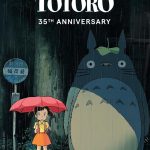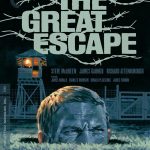The Witcher: Nightmare of the Wolf (2021)
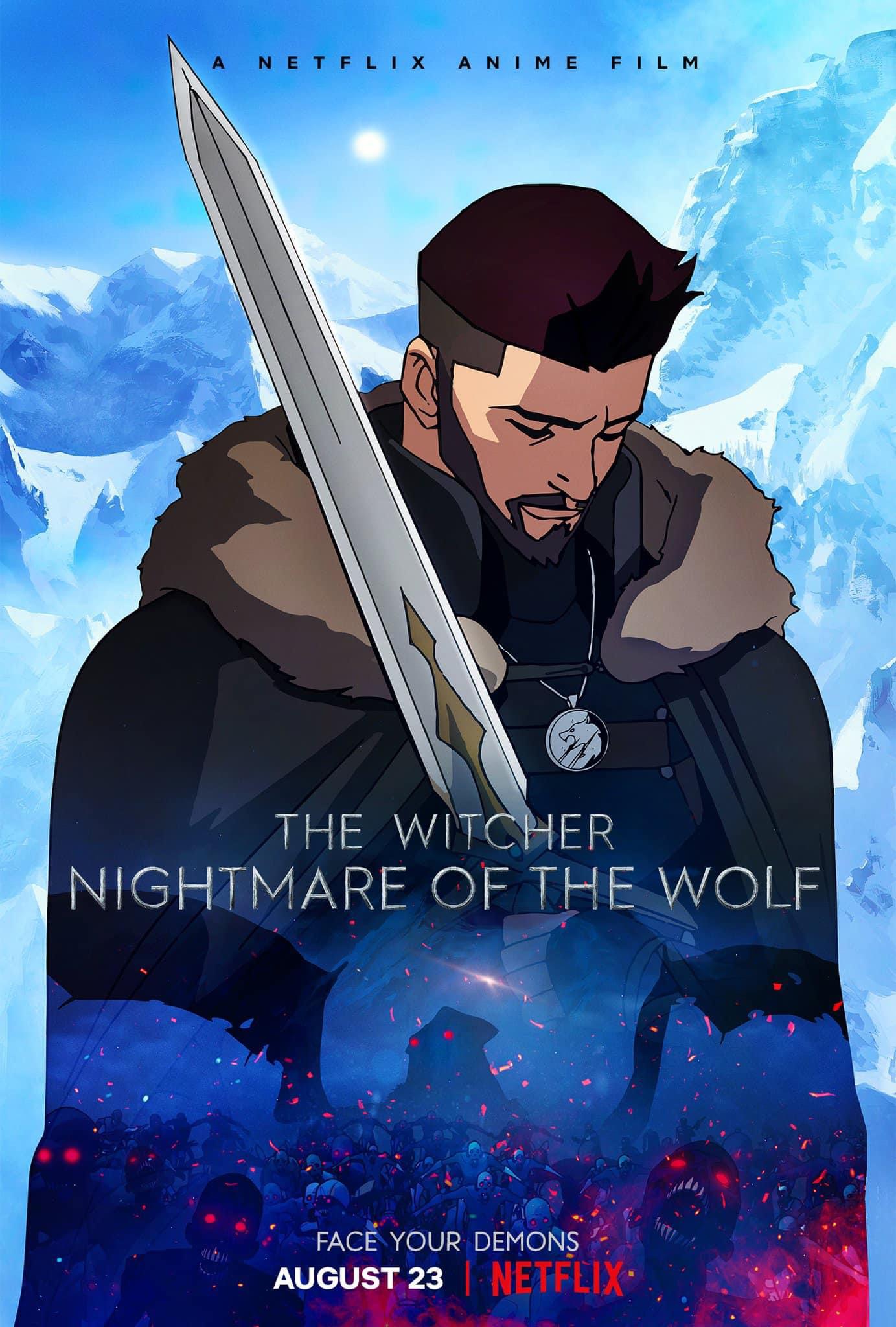
The Witcher: Nightmare of the Wolf (2021), an animated film set in the world of Andrzej Sapkowski’s The Witcher series, is a visually striking and action-packed adventure that provides a deeper look into the backstory of Vesemir, Geralt of Rivia’s mentor. Directed by Kwang Il Han, the film expands on the rich lore of The Witcher universe and serves as both a prequel to the Netflix live-action series The Witcher and a standalone exploration of Vesemir’s past. While the film offers exciting action and stunning animation, it also delves into themes of moral ambiguity, personal sacrifice, and the complexities of the Witcher’s
Suggested videos for you:
Plot Overview:
The story is set years before Geralt’s birth, during Vesemir’s youth. Vesemir (voiced by Theo James) is a brash, young Witcher with a carefree attitude toward the dangerous world he inhabits. He is one of the last of his kind after the tragic fall of Kaer Morhen, the Witcher stronghold, and the decimation of the Witcher order. The film follows his journey as he uncovers dark secrets about the origin of the Witchers, as well as their role in a world plagued by monstrous creatures. When a new monster begins terrorizing the land and a mysterious sorceress named Tetra (voiced by Lara Pulver) enters the scene, Vesemir is forced to confront the harsh realities of his role as a Witcher, his personal demons, and the consequences of his choices.
A central part of the plot involves Vesemir’s relationship with Tetra, who is not only a powerful sorceress but also a complex figure whose goals often conflict with those of the Witchers. As Vesemir grapples with his responsibilities as a protector of humanity, he is drawn into a battle against a dangerous and powerful foe. This journey forces him to reckon with the history of the Witchers, the dangerous mutagens that give them their powers, and the moral costs of their existence. The story builds toward a confrontation that forces Vesemir to make difficult decisions that will change his life forever.
Themes:
The Witcher: Nightmare of the Wolf explores several key themes, most notably the moral complexities of the Witchers and the nature of their existence. Witchers are often seen as heroes, but they are also feared, reviled, and treated as tools by those they protect. This ambivalence is reflected throughout the film as Vesemir, much like Geralt, grapples with the idea of being both a savior and an outcast.
The film also delves into the themes of power, control, and sacrifice. Tetra’s manipulations highlight the seductive nature of power, and her ability to shape Vesemir’s choices serves as a reminder that even the most noble of characters can be influenced by external forces. The relationship between Vesemir and his mentor, Deglan, also explores the idea of legacy and the price of personal choices. As Vesemir learns about the origins of the Witchers and the dark secret behind their creation, he is forced to consider how far he is willing to go to change the world he inhabits.
Another key theme of the film is the exploration of loss and the toll it takes on individuals. Vesemir’s journey is partly motivated by his need to reconcile with the past, particularly his regrets over his previous actions. This emotional struggle is at the heart of the film, making Vesemir a more sympathetic and relatable character. His inner conflict adds depth to the action and ensures that the film’s stakes are more than just external.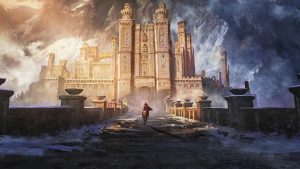
Animation and Visuals:
The animation in Nightmare of the Wolf is one of the film’s strongest points. The film utilizes a stylized, anime-inspired aesthetic that is a departure from the live-action series. The animation is fluid, and the action sequences are intense, with well-choreographed battles between Vesemir and the numerous monsters he faces. The film’s character designs are sharp and dynamic, capturing the gritty, dark tone of The Witcher world while also giving the characters a unique visual identity.
The environments in Nightmare of the Wolf are beautifully rendered, ranging from eerie, mist-filled forests to the gothic, stone architecture of Kaer Morhen. The color palette is often muted and dark, reflecting the grim world the Witchers inhabit. There is a lot of detail in the character’s expressions, which adds an emotional layer to the story, especially during moments of introspection or conflict.
The animation of the monsters is also a highlight. From grotesque beasts to powerful, supernatural entities, each creature feels distinct and menacing. The battles are fast-paced and violent, with blood and gore that are typical of The Witcher universe. This intense action serves as a perfect complement to the emotional weight of Vesemir’s journey.
Character Development:
Vesemir is the heart and soul of the film, and his character arc is compelling and emotional. He starts out as a more carefree, somewhat reckless Witcher, eager to prove his worth. Over the course of the film, however, he matures and begins to understand the true nature of his role in the world. His relationship with Tetra is central to his development, as she challenges his preconceived notions about the world and his place in it. While Tetra represents an alluring, more morally flexible approach to solving problems, Vesemir is forced to confront his own rigid sense of right and wrong.
The dynamic between Vesemir and his mentor, Deglan, is also integral to the story. Deglan serves as a father figure to Vesemir, and his role in Vesemir’s transformation is pivotal. The lessons that Vesemir learns from Deglan about the price of becoming a Witcher are critical to his growth, and the emotional weight of their relationship adds depth to the film.
Tetra, as the film’s antagonist, is also an interesting character. While her motivations are not immediately clear, she represents a more manipulative side of magic and power. Her character contrasts with Vesemir’s idealistic, yet pragmatic approach, and her presence raises questions about the ethics of the Witcher’s existence and the cost of immortality.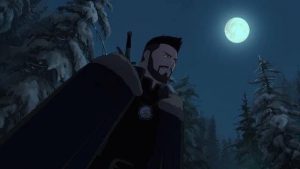
Pacing and Structure:
At just under 90 minutes, Nightmare of the Wolf maintains a brisk pace, balancing action and character development effectively. The plot moves quickly, yet the film still manages to give ample time to Vesemir’s internal struggles and the consequences of his actions. The story’s structure is straightforward, but the emotional stakes feel high due to the intense character development and world-building.
The action sequences are frequent and well-executed, keeping the audience engaged throughout. However, it’s the quieter moments that offer the most depth, particularly as Vesemir reflects on his life and his role in the Witcher order. This blend of action and introspection creates a film that is both exciting and thought-provoking.
Conclusion:
The Witcher: Nightmare of the Wolf is an exciting, visually stunning film that expands the rich world of The Witcher and provides a fascinating look at one of its most important characters, Vesemir. With its engaging plot, complex characters, and stunning animation, it stands as a worthy addition to the Witcher franchise. The film offers both action-packed thrills and emotional depth, exploring themes of power, morality, and sacrifice, while also delivering a memorable character arc for Vesemir.
While it may appeal most to fans of the Witcher universe, particularly those who have enjoyed the Netflix series, Nightmare of the Wolf is accessible enough for newcomers to appreciate. Whether you’re a fan of The Witcher lore or simply enjoy dark fantasy with complex characters, this animated film is a solid, captivating experience that adds rich layers to the larger story of the Witchers.



